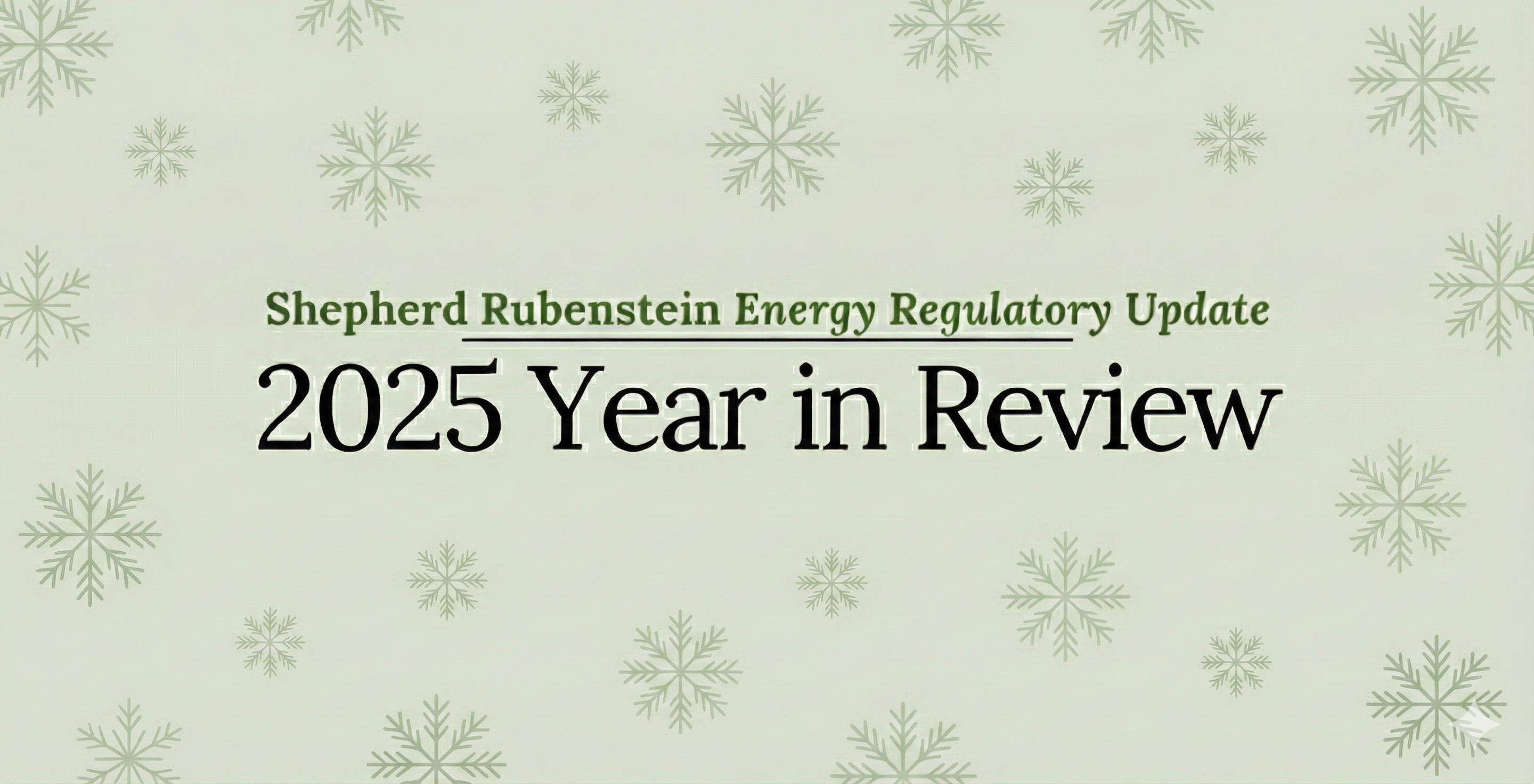Happy New Year and welcome to the latest edition of the Shepherd Rubenstein Energy Regulatory Update, a quarterly round-up of the important developments in the Ontario energy sector. Below are some of the key regulatory happenings between October and December. A reminder, if you have not already, take a look at our special 2021 Year in Review edition.
Ontario Energy Board
The Minister of Energy issued a new Mandate Letter to the Chair of the OEB. The Minister highlighted several initiatives that it expects the OEB to deliver on, including its modernization, EV readiness, natural gas DSM, helping implement the Supporting Broadband and Infrastructure Expansion Act, and designing a dynamic pricing pilot program for non-RPP Class B customers.
The OEB released some noteworthy decisions, including:
- In its decision on the unsettled issues in Ontario Power Generation’s (“OPG”) 2022-2026 Payment Amounts application, the OEB made a permanent disallowance for imprudence of $94M and certain carrying costs incurred for the construction of OPG’s Heavy Water Storage and Drum Handling Facility. It also provided reasons for its approval of a substantial Settlement Proposal;
- Implementing the OEB’s 2015 decision to eliminate Hydro One’s seasonal rate class.
- Approving a Settlement Proposal in the IESO 2020-2021 Revenue Requirement and Fees application.
- Allowing Energy+ recovery of some additional Advanced Capital Module funding for its Southworks facility, but disallowing $350K as imprudent.
- While granting leave to construct to Hydro One for two transmission projects (Richview by Trafalgar Reconductoring and Ansonville by Kirkland Lake Refurbishment), the OEB provided guidance to the IESO regarding the type of evidence that should be filed in support of an application, and commenting on the need for timely examination of alternatives.
The OEB announced the initial membership to its natural gas Integrated Resource Planning Technical Working Group (our own Jay Shepherd was named a member).
In moving forward with its modernization agenda, the OEB made amendments to its Rules of Practice and Procedure on Confidential Filings to streamline the process for considering confidentiality claims and reform how redactions for personal information will be addressed. It also issued new cost of service filing requirements for small electricity distributors (newly defined as those with fewer than 30,000 customers). In its annual letter regarding electricity distribution cost of service filers for the upcoming year, it outlined a revised approach to electricity distributor cost of service deferrals.
After considering stakeholder comments during Q3 2021, the OEB issued new Conservation and Demand Management Guidelines for Electricity Distributors. It also released a revised Notice of Proposal to Amend the Distribution System Code to facilitate connection of Distributed Energy Resources. OEB Staff issued a Bulletin clarifying its view that, for the purposes of net metering, a customer need not own the generation facility to be considered an “eligible generator.”
The OEB provided its initial reporting on the frequency of RPP-TOU switching over the past year. It also released the Regulated Price Plan Pilot Meta-Analysis Final Report, which provides analysis and recommendations related to various pilot and alternative Regulated Price Plan (RPP) price plans and non-price features that have been undertaken over the past few years. In response, the Minister of Energy, using his section 35 authority, has asked the OEB to report back and advise on the design of an optional enhanced time of use rate to incent further demand shifting away from peak periods to lower-demand periods.
Before the end of the year, the OEB announced the launch of the Reliability and Power Quality Review, a comprehensive review of electricity reliability and power quality.
The Regional Planning Process Advisory Group provided its Report to the OEB recommending improvements in the efficiency, effectiveness, and transparency of the current regional planning process in Ontario.
The OEB accepted an Assurance of Voluntary Compliance, from one entity regarding non-compliance related to provision of electricity supply without valid customer authorization. It also issued its inaugural report detailing its compliance and enforcement activities.
Independent Electricity System Operator
The IESO released its 2021 Annual Planning Outlook (APO) Report and its most recent 18-month Reliability Outlook (January 2022-June 2023).
As new technologies and resources become a more significant part of the electricity system, the IESO presented its Enabling Resources Program work plan, released its DER Roadmap, and launched the Distributed Energy Resources (DER) Market Vision and Design Project.
With respect to resource adequacy and procurement, the IESO issued, for stakeholder comment the draft Medium Term RFP and contract, aimed at procuring up to 750MW for a 3-year period, beginning in 2026. It is also considering potential bridging mechanisms to align expiring contracts with the Medium Term RFP commitment period. The IESO began engaging stakeholders on a Long-Term RFQ (to be followed by an RFP). In November, the Minister of Energy issued a letter to the IESO asking it to report back on a number of resource adequacy and procurement initiatives
As a result of the previously mentioned approved OEB Settlement Proposal, with respect to its 2020-21 revenue requirements and fees application, the IESO consulted stakeholders on a procurement fee setting framework.
In early October, the IESO released the much-awaited assessment of the impacts of phasing out natural gas generation by 2030. While the IESO did not recommend doing so, the Minister of Energy followed up by asking for further analysis to be undertaken regarding a moratorium on procurement of new natural gas generation and a pathway to phase-out natural gas and achieve zero emissions in the electricity sector.
The continued impact of COVID-19 caused the Minister of Energy to issue a letter to the IESO asking for options to mitigate the impacts of the pandemic on certain Conservation First Program participants. In late December, the Minister followed up by issuing a directive to further extend project timelines.
The Market Assessment and Compliance Division (MACD) issued a letter of non-compliance and a financial penalty to Alectra for breaches of various Market Rules related to instrument transformer checks.
Legislative and Regulatory
The Government of Ontario introduced and passed Bill 13, the Supporting Businesses and People Act, 2021. The legislation includes amendments to the Electricity Act that create a new two-year limitation period that applies to certain payments, adjustments, and amounts to be settled with the IESO. It also included amendments to the Ontario Energy Board Act, removing the upper limit on the number of commissioners and changing to the process of ministerial review of certain by-laws made by the OEB board of directors.
In the past three months, the Government of Ontario was very busy amending or proposing to amend various regulations:
- Amendments to Ontario Regulation 53/05, to include Small Modular Reactors at OPG’s Darlington site to be a prescribed facility, to allow OPG to recover the project’s prudently incurred costs as determined by the OEB.
- Amendments to Ontario Regulation 95/05, changing the frequency of RPP rate-setting to generally once a year.
- Amendments to Ontario Regulation 363/16, to adjust the Ontario Electricity Rebate, effective November 1, 2021.
- Amendments to Ontario Regulation 161/99, permitting certain Hydro One backhaul network infrastructure projects in the Municipality of Brighton.
- Proposed amendments to Ontario Regulation 429/05, to facilitate an electricity interruptible rate pilot to be developed in conjunction with the IESO.
- Proposed amendments to Ontario Regulation 389/10, to make it easier for condominium corporations and other building owners/administrators to switch suite meter providers from a local distribution company to a Unit Suite Metering Provider, and vice-versa.
- Proposed amendments to Ontario Regulation 429/04, to facilitate an interruptible electricity rate pilot to be developed in conjunction with the IESO.
- Proposed amendments to Ontario Regulation 541/05, to provide greater clarity on eligibility of a customers who are leasing, or financing electricity generation equipment used for net metering.
The Government of Ontario, in furtherance of the Supporting Broadband and Infrastructure Expansion Act passed earlier this year, issued Ontario Regulation 842/21, which among other things, sets a new methodology for pole attachment charges. The OEB subsequently issued a decision for 2022 pursuant to the new methodology, substantially lowering the rate as compared to the 2021 approved rate. The Minister of Energy also proposed new regulation(s) to support and enable the enforceability of its proposed Building Broadband Faster Act Guideline.
Judicial Decisions
In October, an interesting decision was issued from the Alberta Court of Appeal (ABCA) regarding the scope of the no-harm test and the public interest. In AltaLink Management Ltd. v. Alberta (Utilities Commission), the ABCA overturned a decision of the Alberta Utilities Commission (AUC), finding that it had erred in law by making it a condition of approval of the sale of an interest of a transmission line to the Piikani Nation and the Blood Tribe that they could not recover certain audit and hearing costs from ratepayers. The AUC had rejected consideration of cost savings from routing the transmission line through reserve lands because the no-harm test is a forward-looking exercise and also due to the benefits that arise from partnerships with First Nation communities.
In varying the AUC decision, the ABCA adopted a broader view of the no-harm test and the public interest. It noted that the test is not always a forward-looking exercise, and that the AUC was wrong not to consider the cost savings that arose because the transmission line has been routed across the Piikani Nation and the Blood Tribe reserves. The ABCA also commented on the public interest benefits of economic activity on reserves that the project contemplated. The concurring opinion by Justice Feehan is also notable as it discusses in considerable length the requirement that the AUC when exercising its authority, must consider the honour of the Crown and the goal of reconsolidation whenever it engages with Indigenous communities (and their governance entities).
Other News
Another proposed local distribution company merger in southwest Ontario. The municipal shareholders have approved the proposed merger of the parent companies of Kitchener-Wilmot Hydro Inc. and Waterloo North Hydro. OEB approval is still required.
OPG has announced that it would work with Hitachi GE to develop its Small Modular Reactor (SMR) at Darlington.
Things We Are Reading and Listening To
A couple of interesting new reports were released over the past few months, including the Institut de l’énergie Canadian Energy Outlook 2021 – Horizon 2060, and Positive Energy’s Energy Project Decision Systems For Net Zero: Designing For Functionality, Adaptability and Legitimacy. Lazard released its annual analyses on the Levelized Cost of Energy, Storage, and Hydrogen. The excellent, and always nerdy, Energy Transition Show podcast celebrated its 6-year anniversary this fall.
As always, if you have any questions, or think we can be of assistance to you or your organization, please do not hesitate to reach out to any of the Shepherd Rubenstein Lawyers.
Click here for the pdf version.


